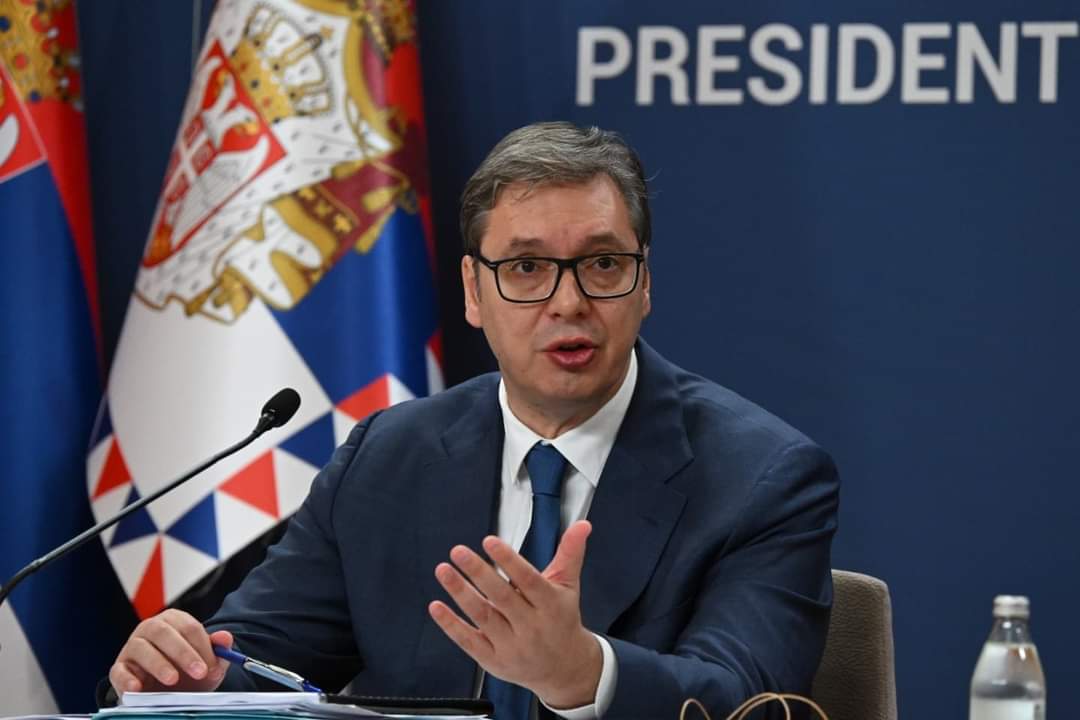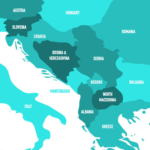Serbian President Aleksandar Vučić’s address he delivered on September 13 was different from his previous speeches. This time, the Serbian leaders issued no warnings to citizens about “difficult times” approaching and neither did he focus on “conspiracies against Serbia”. Instead, he pitched a plan to protect Serbs and the interests of Serbia in Kosovo and Metohija.
Vučić’s main message is that the EU is not up to the task of mediating the conflict so Serbia will give its own try to do something with its “southern province”.
In fact, the settlement of the Kosovo issue has entered a new stage, or better say, returned to previous positions, closer to the era of open-force confrontation.
Five steps, seven points…
Vučić’s plan consists of five steps:
I. Return to the status quo ante (status quo ante bellum (lat.) – “the state that existed before the war”).
II. Kosovo and Metohija is a territory of special social protection.
III. Stability of Serbian institutions in Kosovo and Metohija.
IV. Establishing a special prosecutor’s office.
V. The decision on the illegitimacy of all bodies and institutions on the territory of Kosovo and Metohija after the illegal declaration of independence and the invalidity of all acts they have already adopted or those they are yet to adopt.
Step I, in general terms, involves:
1. Holding local elections in the north of Kosovo and Metohija with the participation of the OSCE mission and under EU control;
2. Return of Serbs to police stations in the north.
3. Return of Serbian judges and prosecutors to performing their duties;
4. Withdrawal of special units of the Kosovo police from the region’s north.
5. Immediate formation of the Association of Serbian Municipalities (ASM).
6. The release of all Serbs detained by the Kosovo police for participating in protests.
7. Resumption of work of Serbian banks and post offices in northern Kosovo and Metohija.
Step II: Kosovo and Metohija shall be a zone of special social protection. This provides for additional payments and increased social guarantees for Serbs living in Kosovo and Metohija.
Step III: the stability of the Serbian institutions of Kosovo and Metohija. This involves continued work of the Serbian administrative bodies shut down by Pristina. They will continue their operations in Serbia, in two cities near the (administrative) border with Kosovo.
Step IV: the creation of a special prosecutor’s office, which will investigate the criminal and illegal actions of employees and officials of temporary bodies in Pristina, who persecute Serbs.
Step V: the decision on the illegitimacy of all institutions in Kosovo and Metohija, created after the unilateral declaration of independence and the invalidity of all the acts that have been adopted or will be adopted by them. According to Vučić, a similar procedure was applied after the end of World War 2, when a new law declared invalid the legal norms adopted during the occupation of Yugoslavia.
The “Vučić Plan” was immediately approved by the Serbian government so its implementation has actually already begun.
One step forward, two steps back
What do these initiatives mean?
First of all, the position is clearly laid down that Kosovo and Metohija are an integral part of Serbia. Belgrade will go for no compromises regarding the international status of Kosovo (although this was foreseen at the outset of the EU-mediated dialogue).
Serbia unequivocally declares illegitimate both the current government in Pristina, the bodies and structures it has created, and the decisions it has made.
It appears that at this stage, Belgrade’s goal is to ensure that Serbian authorities regain control of the situation in Kosovo in order to what they claim is protect their people. In Serbia, international (Western) institutions and their representation in Kosovo – NATO’s KFOR and EU’s EULEX – are not trusted (no longer trusted) in this matter. The latest decisions and actions by the Kosovo authorities, which Belgrade perceives as oppression of Serbs, are cited as the reason behind mistrust (the latest moves included the closure of Serbian (“parallel”) authorities, post offices, and banks, the ban on dinar cash circulation, and detention of Serbs on various charges).
Belgrade’s minimum agenda, or intermediate goal, is the restoration of de facto Serbian rule in the north of Kosovo, in four municipalities with a predominantly Serbian population – North Mitrovica, Leposavic, Zvecan, and Zubin Potok. The Association of Serbian Municipalities (ASM), which according to the Brussels Agreements should be established in the northern regions, can be a tool for achieving this minimum goal, but only if the ASM is formed in line with the Serbian vision. In other words, Belgrade wants the Association of Serbian Municipalities in the north of Kosovo to be more similar to Republika Srpska in Bosnia and Herzegovina than to the mechanisms by which the Serbs were included in the system of power in post-war Croatia.
This position is an obvious – and giant – step back in the EU-mediated Serbian-Kosovo dialogue. Although Serbia is not officially withdrawing from talks, under the current conditions, any further prospects of the negotiation process with the participation of mediators from Brussels seem rather uncertain.
Tougher stance
The position of the Serbian authorities could have been even tougher had Vučić declared Kosovo and Metohija “occupied territory.” According to the Serbian media, such a step was seriously discussed, and there were even expectations that the Serbian president would officially announce the “occupation of KiM” in his Sept 13 speech. However, Vučić stopped short of endorsing the idea. “Occupation, or military occupation, is possible only in international armed conflicts,” he explained, immediately facing criticism from radical and pro-Russian politicians.
Another step that the president is being pushed to take is, apparently, the rejection of the European Union’s mediation in the dialogue between Belgrade and Pristina and the transfer of the Kosovo issue to the exclusive competence of the UN Security Council, or the Contact Group set up by the Security Council, which will include UNSC permanent members.
Belgrade could agree to this based on several arguments:
• the absence of positive results for the Serbs as a result of the 11-year Belgrade-Pristina dialogue, mediated by the EU;
• bias – from the Serbs’ point of view – of European mediators as the absolute majority of EU member states recognized Kosovo, while the EU, as an institution, in a number of directions actually interacts with Kosovo as a separate state;
• and, most importantly, the presence of China and Russia in the Security Council. These two countries are known to consistently support Belgrade’s position on Kosovo, and the Russians even sometimes appear more radical than the Serbs themselves.
Most likely, Moscow will support the transfer of the Kosovo issue from the EU to the UN Security Council. It is possible that they are already doing so. It is no coincidence that Serbian politicians, who are consistent supporters of Russia, are the most actively promoting the change of mediator – from the EU to the UN Security Council.
Kad se vojska na Kosovo vrati
In addition to radical steps in the diplomatic domain, Belgrade might be plotting to expand the range of tools of achieving its goal regarding Kosovo to other areas, first of all, the military field.
In recent years, Serbian leaders are clearly not afraid to resort to “saber rattling”. These are periodic increases in combat readiness of the Serbian armed forces “over the situation in Kosovo”, military exercises, the amassing of troops near the (administrative) border with Kosovo, an appeal to KFOR on the possibility of the Serbian army returning to Kosovo, and a general trend toward militarization.
It is significant that the Serbian leadership directly links the recent return of mandatory military service to the Kosovo issue. Serbian Prime Minister Miloš Vučević, commenting on renewed conscription and the negative reaction to the move on the part of Pristina, said the following: “Had they not been engaged in terror against the Serbs, the state of Serbia would not have had to undertake such significant efforts.”
Thus, if diplomacy fails to produce the results desired the Serbs, we can expect a strengthening of the military component of the Serbian policy towards Kosovo, especially since Vučić in his address on September 13 already announced a concrete step to this end – the drafting of another appeal KFOR on the return of Serbian troops to Kosovo.
There are quite a lot of supporters of developments “in the military direction” both in Serbia and beyond.
This year, on the 25th anniversary of the NATO bombing of Yugoslavia, in the center of Belgrade, several opposition parties and the “People’s Patrol” movement set up a rally where people would banners such as “When the army returns to Kosovo”, “Pray to God and stick to Russia”, and flags with the letter Z, a symbol of the Russian invasion of Ukraine.
Also, last year, the graffiti saying “When the army returns to Kosovo” in Serbian (“Kad se vojska na Kosovo vrati”) were spotted simultaneously in Serbia and in several Russian cities, including Moscow.
For Russia, which, according to its officials, “opposes the collective West in Ukraine”, it is certainly beneficial to inflame the conflict in the Balkans. Therefore, the Russians, through their proxies, will likely continue to promote the scenario of “resolving the Kosovo issue” by force. And, as the plan announced by Vučić showed, Belgrade does listen to Moscow’s “advice”.


